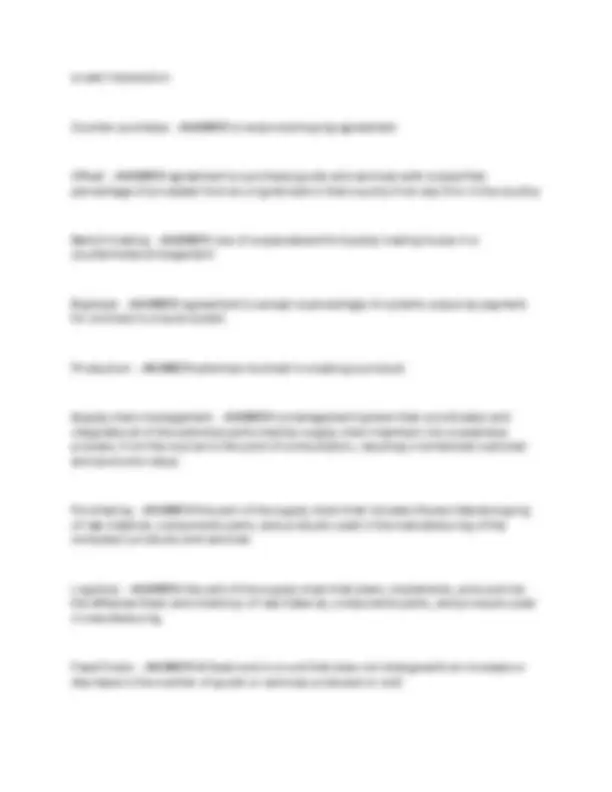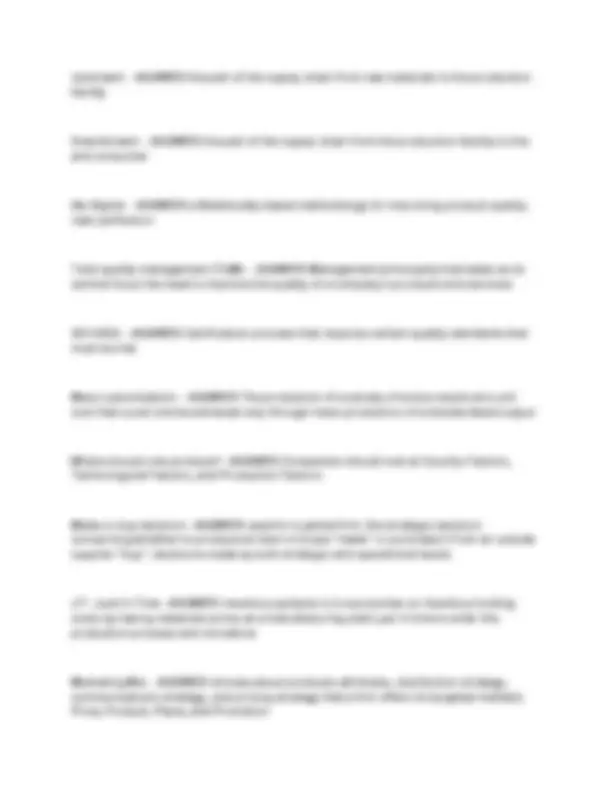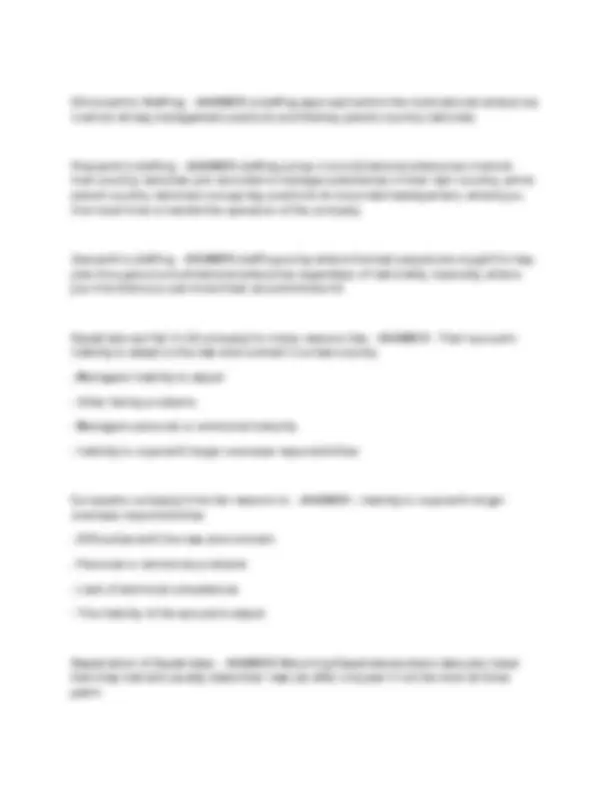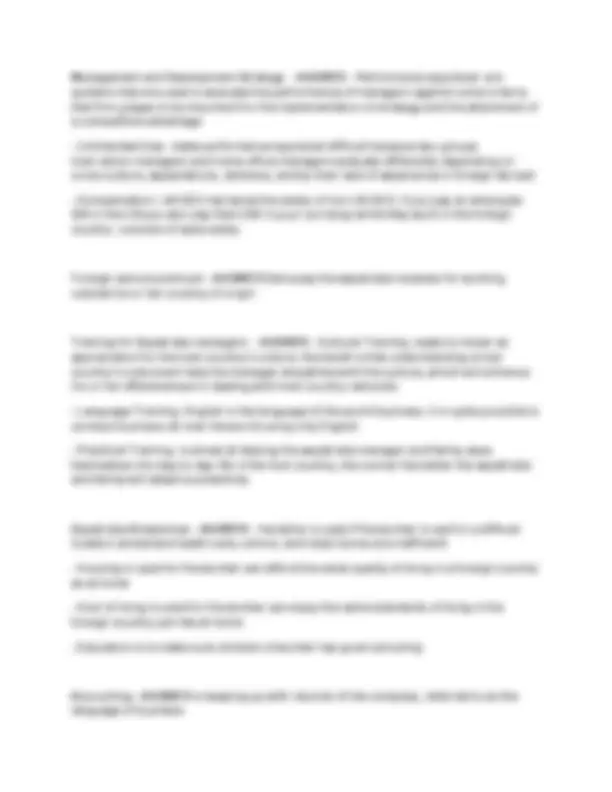








Study with the several resources on Docsity

Earn points by helping other students or get them with a premium plan


Prepare for your exams
Study with the several resources on Docsity

Earn points to download
Earn points by helping other students or get them with a premium plan
Community
Ask the community for help and clear up your study doubts
Discover the best universities in your country according to Docsity users
Free resources
Download our free guides on studying techniques, anxiety management strategies, and thesis advice from Docsity tutors
INTERNATIONAL BUSINESS 4344-830 EXAM 3 WITH CORRECT ANSWERS!!
Typology: Exams
1 / 10

This page cannot be seen from the preview
Don't miss anything!







First mover advantage: - ANSWER advantages accruing to the first to enter a market
First-mover disadvantage: - ANSWER Disadvantages associated with entering a foreign market before other international businesses.
Exporting: - ANSWER Sales of products produced in one country to residents of another country
Disadvantages of Exporting: - ANSWER lower-cost locations for manufacturing abroad, high transport costs can make exporting uneconomical, traffic barriers can make exporting uneconomical
Licensing: - ANSWER Occurs when a firm (the licensor) licenses the right to produce its product, use its production processes, or use its brand name or trademark to another firm (the licensee)
Licensing Agreements: - ANSWER Agreement in which a licensor grants the rights to intangible property to a licensee for a specified period and receives a royalty fee to return
Disadvantage of Licensing: - ANSWER doesn't give a firm the tight control over manufacturing, marketing, and strategy is required for realizing experience curve and location economies; second is competing in a global market may require a firm to coordinate strategic moves across countries by using profits earned in one country to support competitive attacks in another; third is technological know-how to foreign companies where most companies want to control but with licensing they can lose control
Franchising: - ANSWER food and hotels; a specialized form of licensing in which the franchiser sells the intangible property to the franchisee and insists on rules to conduct the business
Tariffs: - ANSWER a tax levied on imports
Strategic Alliances: - ANSWER are cooperative agreements between potential or actual competitors; non-contractual market of two companies; alliances can be terminated in a snap
Timing of Entry: - ANSWER Entry is early when a firm enters a foreign market before other foreign firms and late when a firm enters after other international businesses have established themselves.
Pioneering cost: - ANSWER Costs an early entrant bears that later entrants avoid, such as the time and effort in learning the rules, failure due to ignorance, and the liability of being a foreigner.
Turnkey contracts: - ANSWER a project in which a firm agrees to set up an operating plant for a foreign client and hand over the "key" when the plant is fully operational.
Joint Ventures: - ANSWER a cooperative undertaking between two or more firms
Wholly owned subsidiaries/ greenfield subsidiaries: - ANSWER a subsidiary in which the firm owns 100 percent of the stock
Fewer than 1% are involved an international trade most US businesses are small local companies. - ANSWER
Direct Investment: - ANSWER occurs when a firm invests directly in facilities to produce or market a good or service in a foreign country
a cash transaction
Counter purchase: - ANSWER a reciprocal buying agreement
Offset: - ANSWER agreement to purchase goods and services with a specified percentage of proceeds from an original sale in that country from any firm in the country
Switch trading: - ANSWER Use of a specialized third-party trading house in a countertrade arrangement
Buyback: - ANSWER agreement to accept a percentage of a plants output as payment for contract to a build a plant
Production: - ANSWER activities involved in creating a product
Supply chain management: - ANSWER a management system that coordinates and integrates all of the activities performed by supply chain members into a seamless process, from the source to the point of consumption, resulting in enhanced customer and economic value
Purchasing: - ANSWER the part of the supply chain that includes the worldwide buying of raw material, components parts, and products used in the manufacturing of the company's products and services
Logistics: - ANSWER the part of the supply chain that plans, implements, and controls the effective flows and inventory of raw material, components parts, and products used in manufacturing
Fixed Costs: - ANSWER A fixed cost is a cost that does not change with an increase or decrease in the number of goods or services produced or sold
Upstream: - ANSWER the part of the supply chain from raw materials to the production facility
Downstream: - ANSWER the part of the supply chain from the production facility to the end-consumer
Six-Sigma: - ANSWER a Statistically based methodology for improving product quality; near perfection
Total quality management (TQM): - ANSWER Management philosophy that takes as its central focus the need to improve the quality of a company's products and services
ISO 9000: - ANSWER Certification process that requires certain quality standards that must be met
Mass customization: - ANSWER The production of a variety of end products at a unit cost that could one be achieved only through mass production of a standardized output
Where should one produce? - ANSWER Companies should look at Country Factors, Technological Factors, and Production Factors
Make-or-buy decision - ANSWER used for a global firm; the strategic decision concerning whether to produce an item in-house "make" or purchase it from an outside supplier "buy"; decisions made by both strategic and operational levels
JIT: Just-In-Time - ANSWER Inventory systems is to economize on inventory holding costs by having materials arrive at a manufacturing plant just in time to enter the production process and not before
Marketing Mix: - ANSWER choices about products attributes, distribution strategy, communications strategy, and pricing strategy that a firm offers its targeted markets; Price, Product, Place, and Promotion
Five things to avoid on the global market: - ANSWER know the global laws, product name make sure name isn't disrespectful or vulgar, search like google search, know the country's culture, and have a social media to stay connected to customers
Push strategy: - ANSWER means you push the product with your customers; face-to-face like a car salesman or salesman who comes to your house
Pull strategy: - ANSWER use an advertisement to get the product out there; if you standardized the product you save money
Pricing helps determine what price your product will be sold - ANSWER
Price elasticity: - ANSWER a measure of how responsive demand for a product is to changes in prices (a small change will change the demand entirely)
Predatory pricing: - ANSWER is the use of price as a competitive weapon to drive weaker competitors out of a national market; Walmart is accused all over the world of lowering their prices to wipe out the competition and then raising their prices
Human resource management (HRM): - ANSWER activities an organization conducts to use its human resources effectively. Managers did the three primary things to make sure everything worked efficiently which is one is recruitment, two is Salary and Benefits, and three is training.
Expatriate Manager: - ANSWER a national of one country appointed to a management position in another country
Staffing policy: - ANSWER strategy concerned with selecting employees for particular jobs
Corporate culture (organizational culture) - ANSWER the shared experiences, stories, beliefs, and norms that characterize an organization
Ethnocentric Staffing: - ANSWER a staffing approach within the multinational enterprise in which all key management positions are filled by parent-country nationals
Polycentric staffing: - ANSWER staffing policy in a multinational enterprise in which host-country nationals are recruited to manage subsidiaries in their own country, while parent country nationals occupy key positions at corporate headquarters; where you hire local hires to handle the operation of the company
Geocentric staffing: - ANSWER staffing policy where the best people are sought for key jobs throughout a multinational enterprise regardless of nationality; basically, where you hire them you can move them around the world
Expatriate can fail in US company for many reasons like: - ANSWER - Their spouse's inability to adapt to the new environment in a new country.
Europeans company firms fail reasons to: - ANSWER - Inability to cope with larger overseas responsibilities
Repatriation of Expatriates: - ANSWER Returning Expatriate workers take jobs lower than they had and usually leave their new job after one year if not the most at three years
Finances - ANSWER make the investment decisions of the company
Biggest Problem in International Accounting: - ANSWER Every country has different accounting systems none are alike
Accounting standards: - ANSWER are the rules for preparing financial statements they define what is useful accounting information
Auditing standards: - ANSWER specify the rules for performing an audit, the technical process by which an independent person the auditor gathers evidence for determining if financial accounts conform to required accounting standards and if they are also reliable
Double taxation - ANSWER Occurs when the income of a foreign subsidiary is taxed both by the host-country government and by the parent company's home government
Taxes credit: - ANSWER allows a firm to reduce the taxes paid to the home government by the amount of taxes paid to the foreign govt
Tax treaty: - ANSWER the agreement between two countries specifying what items of income will be taxed by the authorities of the country where the income is earned.
Tax heavens: - ANSWER a country with exceptionally low, or even no income taxes
IASB: - ANSWER International Accounting Standards Board; formed in 2001 to replace the International Accounting Standards Committee, is responsible for developing International Financial Reporting Standards and promotes the standards globally